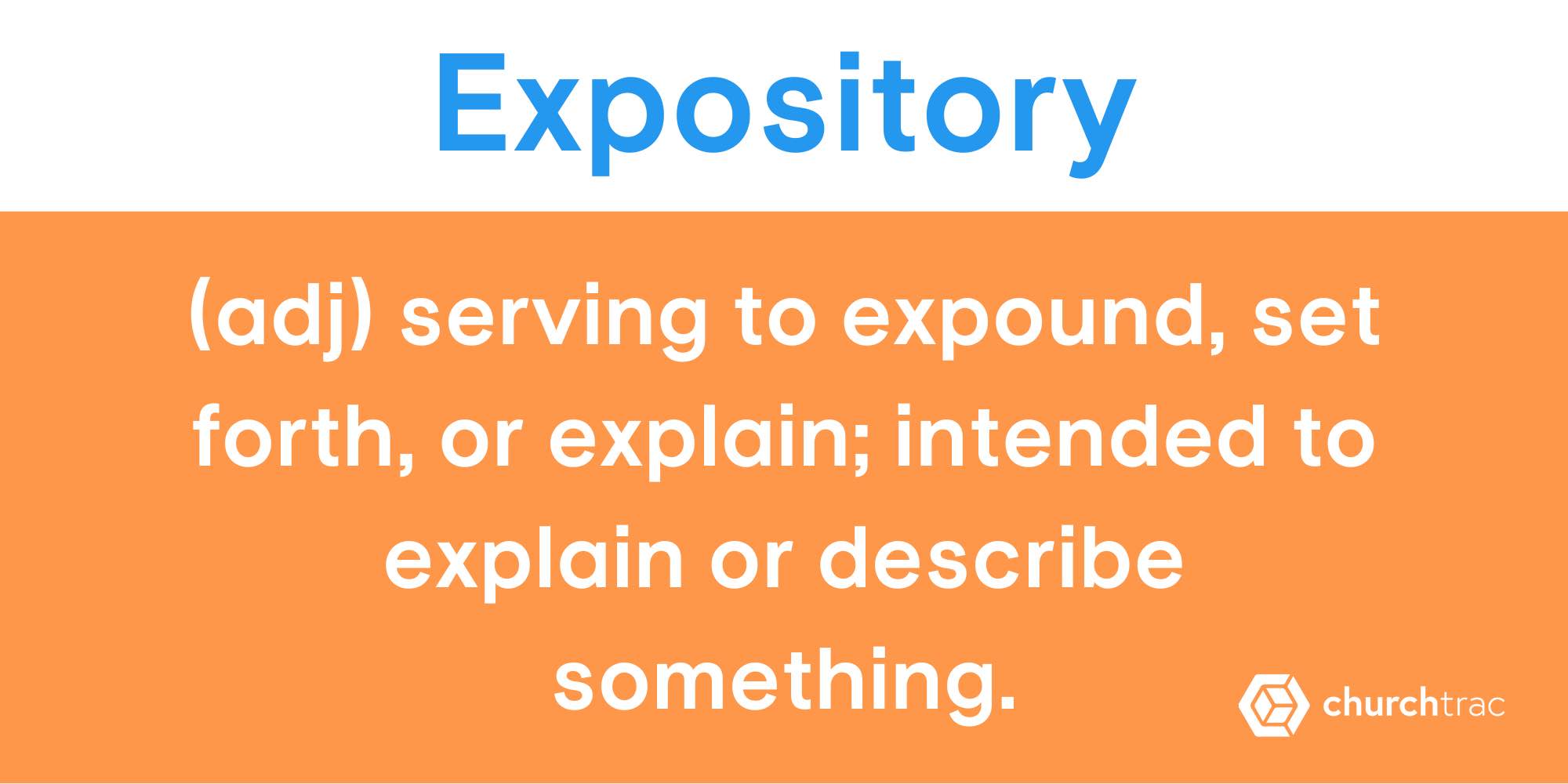The Ultimate Guide to Expository Preaching

As a preacher or pastor, effectively communicating God's Word is paramount to the spiritual growth and understanding of your congregation. One powerful method of achieving this is through expository preaching. Expository preaching is a teaching method that seeks the accurate interpretation and application of Scripture.
Unfortunately, some misconceptions may hinder preachers from embracing this approach. In this article, we will tackle these myths, clarify the concept of expository preaching, and guide you through its benefits. Furthermore, we will walk you through the process of preparing an expository sermon, offer tips for successful delivery, and provide examples of exceptional expository preaching. Lastly, we will answer some frequently asked questions.
What is Expository Preaching?
First, let's define expository preaching.
Expository:
(adj) serving to expound, set forth, or explain; intended to explain or describe something.Expository preaching is a philosophy of preaching and teaching that attempts to not only explain a specific assage of Scripture within its context but also offer applicable lessons from that passage to the audience. This approach ensures the original message is conveyed accurately, minimizing distortion or personal bias. It allows the Word of God to speak for itself, providing actionable wisdom and a clear understanding of the intended meaning.
In his book Expositional Preaching, Devid Helm puts it like this - "Expositional preaching is empowered preaching that rightfully submits the shape and emphasis of the sermon to the shape and emphasis of a biblical text."

The Types of Expository Preaching
There can be a lot of overlap between preaching methods, so you will find different opinions on what expository preaching is and is not. Not to mention, it is also possible to combine two or more methods into a single sermon! However, below is a brief overview of different preaching styles and how they relate to expository preaching.
Verse-by-Verse Preaching
This approach is often what first comes to mind when someone mentions expository preaching. However, this isn't the only way to exposit God's word.
This type of expository preaching takes a book or passage and seeks to preach by observing each verse in turn. I once went to a church where the pastor would preach through the entire Bible one verse at a time. When he finally reached the end of Revelation, he would turn to Genesis 1:1 and keep going. The process would take a couple of years at a time, but he blessed his congregation by exposing them to the entire Bible that way.

Strengths of Verse-by-Verse Preaching method
The strength of verse-by-verse preaching is that it ensures certain parts of Scripture are never passed over or ignored. By tackling every verse, you also get each verse within its full context.
Weaknesses of Verse-by-Verse Preaching method
Verse-by-verse preaching can suffer from the "error of reductionism", which is looking at what only one verse or passage of Scripture says on a topic, rather than hearing the "whole counsel of God" on that matter.
Thematic/Doctrinal Preaching
Scripture often addresses a topic or theme in multiple different books and through many different authors. It makes sense to craft a sermon that seeks to pull all of these references together so that the audience gets the full picture. Of course, the key is to still allow the text to dictate the focus of the sermon.

Strengths of Thematic Preaching method
The strength of thematic preaching is that it allows the hearer to receive the "whole counsel of God" on a core doctrine.
Weaknesses of Thematic Preaching method
Though 30-60 minutes of preaching is a lot, it's still tough to fit several different Bible passages into one message and cover each one as deeply as it deserves.
Narrative Preaching
The Bible is ultimately a story. Narrative preaching steps into the flow of that story.
Narrative exposition of the Biblical text walks through a given story in the Bible from beginning to end, showing the full narrative arc of that portion of Scripture. However, the preacher must also connect that story to the larger story of the Bible, which points to Christ.

Strengths of Narrative Preaching method
The strength of narrative preaching is that it connects individual stories to the bigger picture, revealing how everything in the Bible helps us understand Jesus.
Weaknesses of Narrative Preaching method
Like thematic preaching, fitting the entirety of a story into one sermon can be tough. The risk is having to leave out some elements or details of the story to fit the timeframe of your sermon.
Topical Preaching
Yes, you read that right. Topical preaching can be expositional preaching!
Many confuse topical and expositional as opposing methods, and it's often framed that way even by prominent pastors and thought leaders. However, if done with care, you can faithfully exposit the truth of God's word with a topical sermon.
Remember, expository preaching is not a method, so much as it is a philosophy. An expositor of God's word seeks to reveal the main point of a passage and convey the truths of that passage with an eye toward application. That can be done topically as easily as any other method.

Strengths of Topical Preaching method
The topical approach traces a topic across the whole Bible, giving your members a 30,000ft view of Scripture.
Weaknesses of Topical Preaching method
Again, fitting the entirety of even just one element of Scripture into a sermon is a challenge. Also, framing your sermon around a topic instead of a focal passage risks making Scripture fit your ideas about that topic, rather than being directed by God's word in your study and preaching.
The Benefits of Expository Preaching
Expository preaching offers a multitude of advantages over other preaching methods, making it a powerful tool for conveying God's Word. Some of the most notable benefits include:
Comprehensive understanding: By systematically preaching through entire books or sections of the Bible, expository preaching ensures that both you and your congregation gain a deeper and more complete understanding of the Scripture. This approach prevents selective preaching and guarantees that difficult or controversial passages are not overlooked.
Contextual accuracy: Expository preaching maintains the integrity of the Scripture by focusing on the context and original intent of each passage. This method promotes accurate interpretation and helps your audience grasp the true meaning of the text, avoiding misrepresentations or out-of-context applications.
Balanced spiritual nourishment: Since expository preaching covers a wide range of topics and issues found in the Scripture, it provides a balanced spiritual diet for your congregation. This method exposes the audience to the full counsel of God, addressing various aspects of Christian life and doctrine.
Enhanced application: As you unpack the meaning and relevance of each passage, your audience is better equipped to apply the teachings to their own lives. By grounding the sermon in the text's original intent, you can offer practical and specific applications that resonate with your congregation.
Encourages biblical literacy: Expository preaching fosters a love for the Word of God and encourages the congregation to study and engage with the Scripture independently. As your people become more familiar with the Bible's structure, themes, and teachings, they develop a greater appreciation for its relevance to their daily lives.

Expository preaching is a highly effective way to teach God's Word, as it ensures a comprehensive and accurate understanding of the Scripture, promotes spiritual growth, and enables your members to better apply biblical teachings to their lives.
The Process of Preparing an Expository Sermon
Preparing an expository sermon requires a diligent and systematic approach to ensure the accurate interpretation and application of the selected Scripture passage. There is no one-size-fits-all method for preparing an expositional sermon, but the step-by-step guide below can help you as you learn this powerful approach:
Select a passage and study the context: Begin by choosing a specific passage from the Bible, ideally from a book or section that you plan to preach through systematically. Examine the historical, cultural, and literary context surrounding the passage to gain a deeper understanding of its meaning and relevance.
Perform thorough exegesis: Exegesis is the process of extracting the original meaning and intention of a biblical passage. Utilize various tools, such as multiple translations, commentaries, and scholarly resources, to analyze the text. Pay attention to the structure, key themes, and literary devices present in the passage. Identify the main point of the passage and make that the main point of your sermon.
Develop a clear argument from the text: Based on your exegesis, formulate a central argument or proposition that captures the passage's main message. This statement should be concise, clear, and grounded in the text. It will serve as the foundation for the sermon and guide your congregation's understanding of the passage.
Apply the text to the lives of your listeners: Consider how the passage's message and principles apply to the lives of your congregation. Identify specific, practical applications that are relevant to their spiritual growth, daily struggles, and Christian walk.
Structure the sermon: Organize your sermon around the central argument, exegesis, and application. Create an outline that clearly and logically presents your points, supporting each with evidence from the text. Ensure that the sermon remains focused on the passage and avoids unnecessary tangents or personal opinions.

By following this process and dedicating time to prayerful preparation, you can create an expository sermon that accurately conveys the meaning of the Scripture and effectively communicates its relevance to your congregation.
Tips for Effective Exposition
While the content of your sermon is crucial, the manner in which you deliver it can significantly impact its effectiveness. To enhance your expository preaching, consider these practical tips:
Use illustrations and stories: Illustrations and anecdotes can help clarify complex concepts, making the message more relatable and engaging for your audience. Be selective in choosing illustrations, ensuring they are relevant and reinforce the point you are making
Engage your audience: Connect with your congregation by making eye contact, asking rhetorical questions, and sharing personal experiences. Demonstrating genuine passion and enthusiasm for the message can also inspire and motivate
Be clear and concise: Strive for clarity in both your content and delivery. Avoid jargon or complex theological terms that may confuse your audience. Instead, use everyday language and concise explanations to ensure your message is accessible and easy to understand
Stay true to the text: Focus on the passage's intended meaning, and avoid using it as a springboard for unrelated topics or personal agendas. Resist the temptation to read into the text, and always ground your interpretations and applications in the context and original intent of the Scripture
Know your audience: While it's essential to be faithful to the text, also consider the needs, concerns, and context of your congregation. Tailor your applications and illustrations to resonate with their life experiences and address their spiritual needs
Keep Trying: Regularly solicit feedback from trusted peers or mentors to identify areas for improvement. Invest in ongoing learning and development through continued study, attending conferences, or engaging in mentorship programs. Keep practicing the method until you find your voice and a manageable routine

By incorporating these tips into your expository preaching, you can enhance your delivery, engage your audience more effectively, and ensure your message has the desired impact on their spiritual growth and understanding of God's Word.
Examples of Great Expository Preachers
Throughout history, several preachers have made significant contributions to the art of expository preaching. Their sermons demonstrate excellence in interpretation, engaging delivery, and practical application. Studying their techniques can offer valuable insights and inspiration for aspiring expository preachers like you. Here are a few notable examples:
John MacArthur
A prominent pastor and Bible teacher, John MacArthur is known for his verse-by-verse exposition of the Scripture. His clear, systematic approach and commitment to biblical accuracy have made him an influential figure in expository preaching. MacArthur's sermons often include detailed historical context and careful explanation of the text's meaning, providing practical applications for the congregation.
Alistair Begg
Alistair Begg, the senior pastor at Parkside Church, is a gifted communicator with a passion for expository preaching. His warm, conversational style engages the audience while he unpacks the meaning of the Scripture with precision and clarity. Begg's sermons emphasize the relevance of the Bible to everyday life, using relatable illustrations and anecdotes to bring the text to life.
Charles Spurgeon
Known as the "Prince of Preachers," Charles Spurgeon was a prolific 19th-century preacher renowned for his expository preaching skills. Spurgeon had an extraordinary ability to draw out deep insights from the text and present them in a compelling, vivid manner. His sermons combined rich theological understanding with practical application, making the Word of God accessible. His sermons have inspired millions of believers around the world for over 100 years!
Martyn Lloyd-Jones
A prominent British preacher, Martyn Lloyd-Jones was a strong advocate for expository preaching. His meticulous, verse-by-verse approach emphasized the need for accurate interpretation and clear explanation of the Scripture. Lloyd-Jones' sermons were characterized by their depth, theological precision, and practical relevance, inspiring many preachers to adopt the expository method.
J. Vernon McGee
Founder of Thru the Bible, J. Vernon McGee was a radio preacher who developed a 5-year cycle for preaching through the entire Bible. He used this method in his broadcasts, sharing Biblical truths with thousands of listeners.
By examining the techniques and approaches of these great expository preachers, you can gain valuable insights into the art of expository preaching. Emulating their dedication to biblical accuracy, engaging delivery, and practical application can help you refine your skills and deepen the impact of your sermons.
Frequently Asked Questions About Expository Preaching
Here are answers to common questions about expository preaching:
- How long should an expository sermon be?
The ideal length of an expository sermon can vary depending on factors such as the passage's complexity, the congregation's attention span, and cultural expectations. Generally, a sermon should be long enough to cover the main points and applications thoroughly but concise enough to maintain audience engagement. Most sermons range between 25 to 45 minutes with the median sermon length being 40 minutes according to Pew Research; however, preachers should prioritize clarity and effectiveness over adhering to a specific time frame.
- Is it okay to use commentaries in expository preaching?
Yes, using commentaries can be incredibly beneficial in expository preaching, as they offer valuable insights, historical context, and interpretations from respected scholars. Commentaries can help preachers better understand the text, identify key themes, and avoid misinterpretations. However, it is essential to use commentaries as a supplementary resource, not as a substitute for personal study, prayerful reflection, and the Holy Spirit's guidance on the Scripture. Additionally, it's wise to consult multiple commentaries to gather a variety of perspectives and avoid relying too heavily on only one source.
- Can expository preaching be combined with other preaching methods?
While expository preaching is primarily focused on explaining and applying a specific passage of Scripture, it can certainly be combined with other methods, such as topical or textual preaching. For example, a preacher may use an expository approach to address a specific theme or topic from a biblical perspective. The key is to maintain the principles of expository preaching, such as accurate interpretation, contextual understanding, and practical application, regardless of the exact method(s) employed.
- How can I choose the right passage for an expository sermon?
Selecting a passage for expository preaching can depend on several factors, including your congregation's needs, the overall preaching plan, or the Holy Spirit's guidance. Many preachers choose to work through entire books of the Bible systematically, ensuring a comprehensive understanding of the Scripture. Others may focus on specific sections or themes relevant to their congregation. Prayerfully consider the needs of your audience and the guidance of the Holy Spirit as you choose the passage for your sermon.
- What are the disadvantages of expository preaching?
The main point of the passage you're expositing may not be immediately relevant to or meet the needs of your audience, making it lose its potency. Also, unless you're using topical and narrative sermons, expository sermons that are primarily exegetical can lack a flow or unity. And finally, focusing on just one passage risks missing out on the fullness of the Biblical witness on a topic.
Expositional Preaching is Preaching Faithfully
Expository preaching is an essential tool for effectively communicating God's Word to your congregation. By staying true to the original intent of the Scripture, this approach ensures a comprehensive understanding of the truth of God, fostering spiritual growth and enabling practical application in the lives of your members.
As you embark on the journey to master the art of expository preaching, remember the importance of diligent study, prayerful preparation, and continuous improvement. You will not only deepen your own understanding of the Bible but also equip your flock to grow in their faith and apply the teachings of Scripture to their daily lives.

|
Matt
|